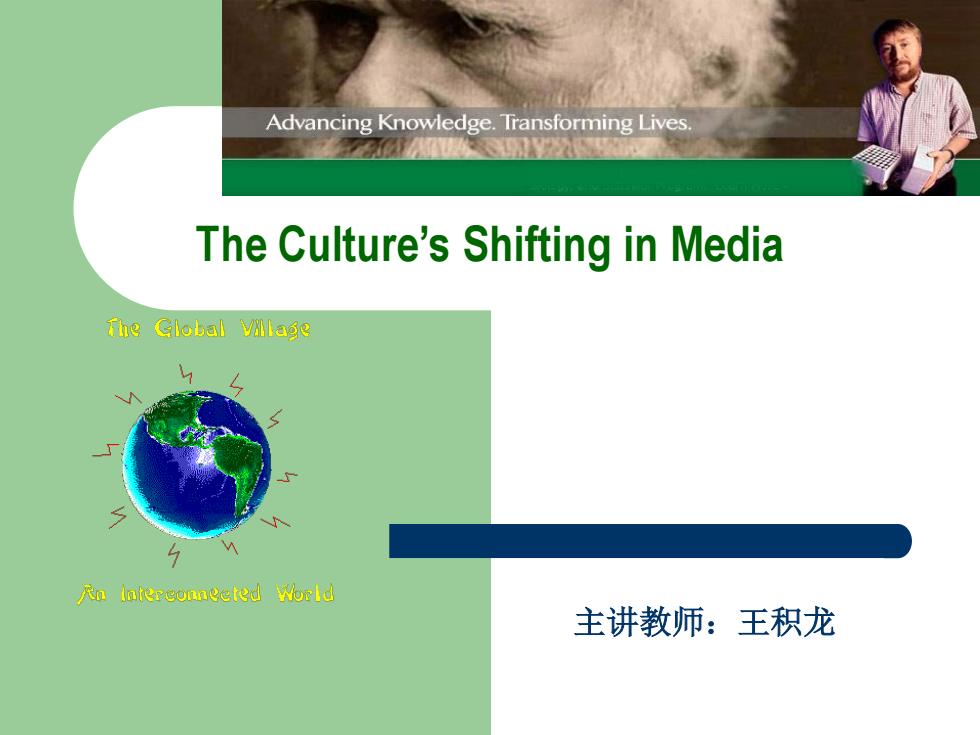
Advancing Knowledge.Transforming Lives The Culture's Shifting in Media The Global Vlage An Interconneeted World 主讲教师:王积龙
The Culture’s Shifting in Media 主讲教师:王积龙
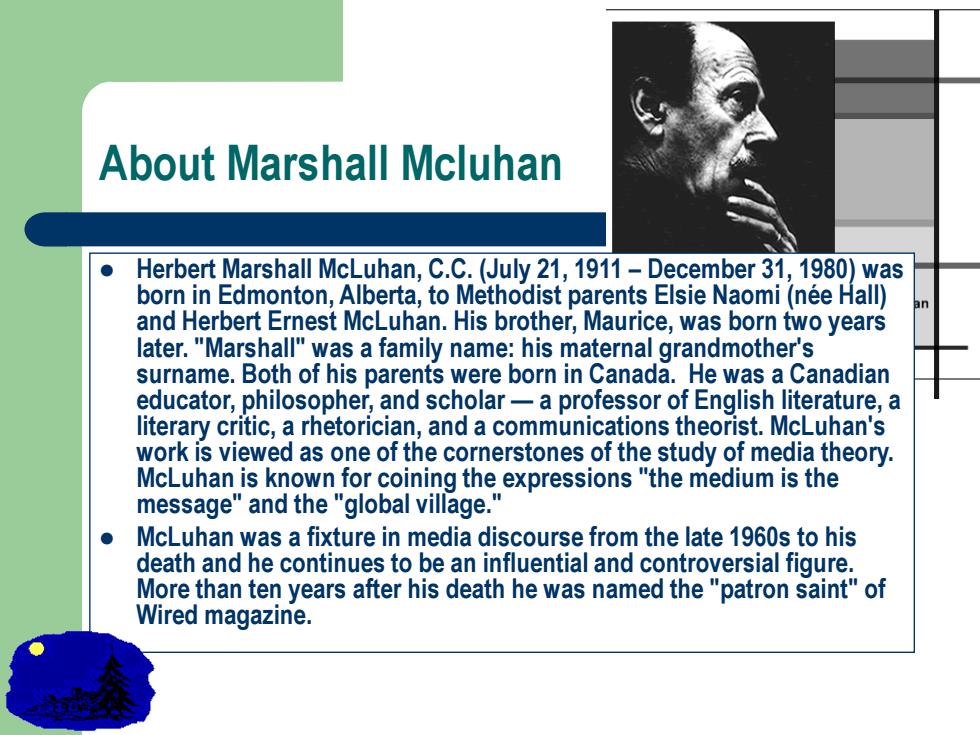
About Marshall Mcluhan ● Herbert Marshall McLuhan,C.C.(July 21,1911-December 31,1980)was born in Edmonton,Alberta,to Methodist parents Elsie Naomi(nee Hall) and Herbert Ernest McLuhan.His brother,Maurice,was born two years later."Marshall"was a family name:his maternal grandmother's surname.Both of his parents were born in Canada.He was a Canadian educator,philosopher,and scholar-a professor of English literature,a literary critic,a rhetorician,and a communications theorist.McLuhan's work is viewed as one of the cornerstones of the study of media theory. McLuhan is known for coining the expressions"the medium is the message"and the "global village.' ● McLuhan was a fixture in media discourse from the late 1960s to his death and he continues to be an influential and controversial figure. More than ten years after his death he was named the "patron saint"of Wired magazine
About Marshall Mcluhan Herbert Marshall McLuhan, C.C. (July 21, 1911 – December 31, 1980) was born in Edmonton, Alberta, to Methodist parents Elsie Naomi (née Hall) and Herbert Ernest McLuhan. His brother, Maurice, was born two years later. "Marshall" was a family name: his maternal grandmother's surname. Both of his parents were born in Canada. He was a Canadian educator, philosopher, and scholar — a professor of English literature, a literary critic, a rhetorician, and a communications theorist. McLuhan's work is viewed as one of the cornerstones of the study of media theory. McLuhan is known for coining the expressions "the medium is the message" and the "global village." McLuhan was a fixture in media discourse from the late 1960s to his death and he continues to be an influential and controversial figure. More than ten years after his death he was named the "patron saint" of Wired magazine
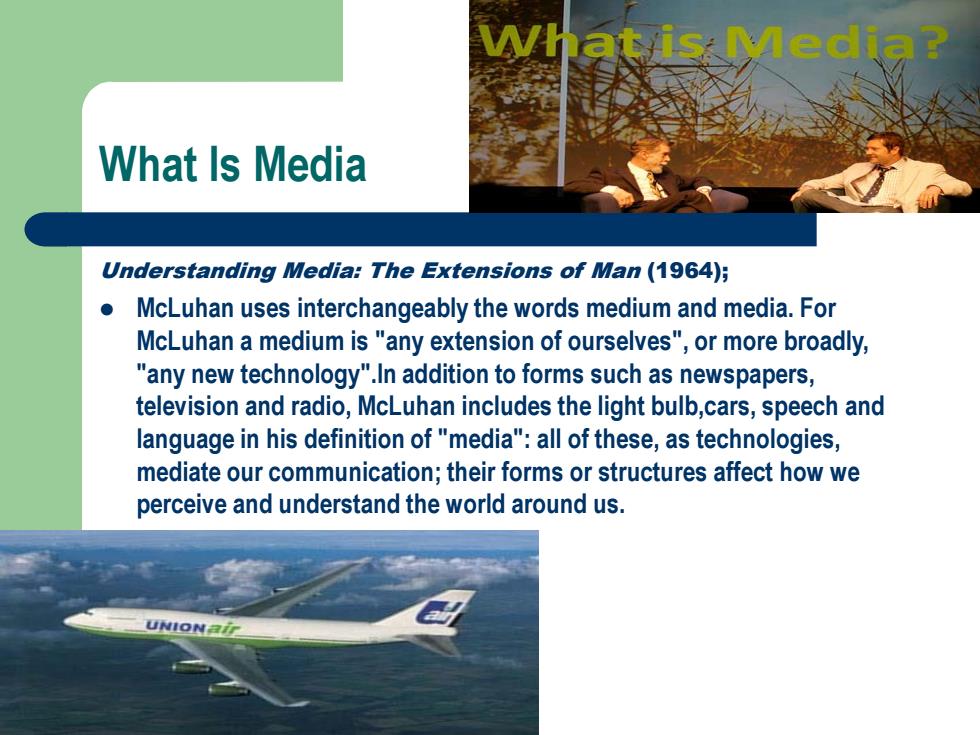
Nhatis Media? What Is Media Understanding Media:The Extensions of Man (1964); ● McLuhan uses interchangeably the words medium and media.For McLuhan a medium is "any extension of ourselves",or more broadly, "any new technology".In addition to forms such as newspapers, television and radio,McLuhan includes the light bulb,cars,speech and language in his definition of "media":all of these,as technologies, mediate our communication;their forms or structures affect how we perceive and understand the world around us. UNION
What Is Media Understanding Media: The Extensions of Man (1964); McLuhan uses interchangeably the words medium and media. For McLuhan a medium is "any extension of ourselves", or more broadly, "any new technology".In addition to forms such as newspapers, television and radio, McLuhan includes the light bulb,cars, speech and language in his definition of "media": all of these, as technologies, mediate our communication; their forms or structures affect how we perceive and understand the world around us
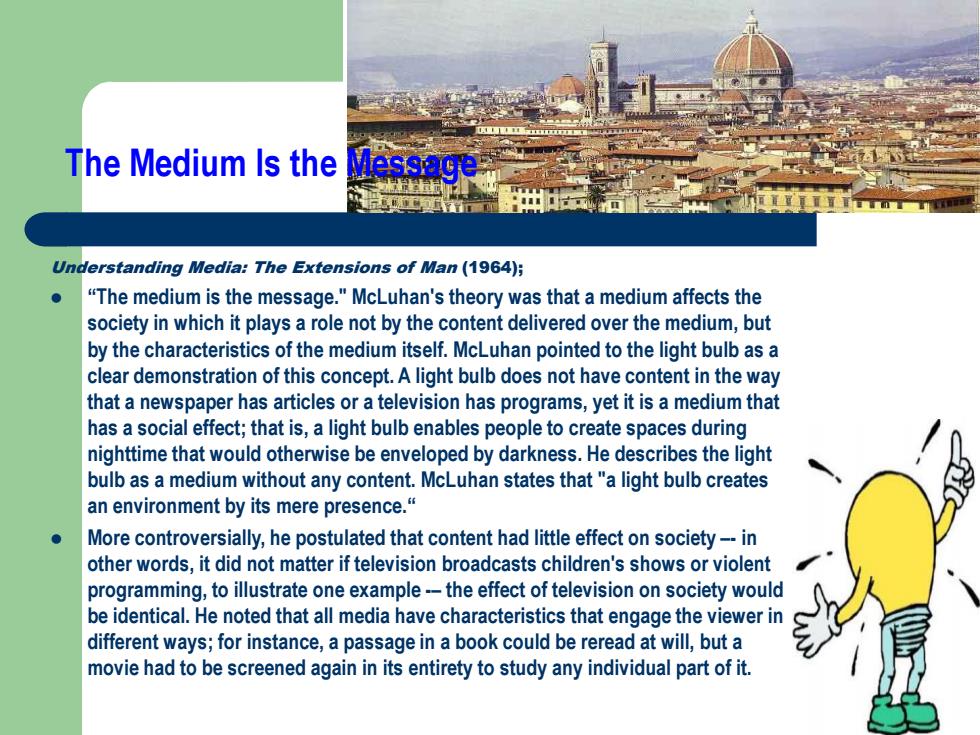
The Medium Is the Message Understanding Media:The Extensions of Man (1964); ● "The medium is the message."McLuhan's theory was that a medium affects the society in which it plays a role not by the content delivered over the medium,but by the characteristics of the medium itself.McLuhan pointed to the light bulb as a clear demonstration of this concept.A light bulb does not have content in the way that a newspaper has articles or a television has programs,yet it is a medium that has a social effect;that is,a light bulb enables people to create spaces during nighttime that would otherwise be enveloped by darkness.He describes the light bulb as a medium without any content.McLuhan states that"a light bulb creates an environment by its mere presence." More controversially,he postulated that content had little effect on society--in other words,it did not matter if television broadcasts children's shows or violent programming,to illustrate one example--the effect of television on society would be identical.He noted that all media have characteristics that engage the viewer in different ways;for instance,a passage in a book could be reread at will,but a movie had to be screened again in its entirety to study any individual part of it
Understanding Media: The Extensions of Man (1964); “The medium is the message." McLuhan's theory was that a medium affects the society in which it plays a role not by the content delivered over the medium, but by the characteristics of the medium itself. McLuhan pointed to the light bulb as a clear demonstration of this concept. A light bulb does not have content in the way that a newspaper has articles or a television has programs, yet it is a medium that has a social effect; that is, a light bulb enables people to create spaces during nighttime that would otherwise be enveloped by darkness. He describes the light bulb as a medium without any content. McLuhan states that "a light bulb creates an environment by its mere presence.“ More controversially, he postulated that content had little effect on society –- in other words, it did not matter if television broadcasts children's shows or violent programming, to illustrate one example -– the effect of television on society would be identical. He noted that all media have characteristics that engage the viewer in different ways; for instance, a passage in a book could be reread at will, but a movie had to be screened again in its entirety to study any individual part of it. The Medium Is the Message

The Medium Is the Message Understanding Media:The Extensions of Man(1964); McLuhan says that the conventional pronouncements fail in studying media because they pay attention to and focus on the content,which blinds them to see its actual character,the psychic and social effects.Significantly,the electric light is usually not even regarded as a media because it has no content.Instead,McLuhan observes that any medium"amplifies or accelerates existing processes",introduces a"change of scale or pace or shape or pattern into human association,affairs,and action",resulting in 'psychic,and social consequences";this is the real "meaning or message"brought by a medium,a social and psychic message,and it depends solely on the medium itself, regardless of the 'content'emitted by it.This is basically the meaning of "the medium is the message
Understanding Media: The Extensions of Man (1964); McLuhan says that the conventional pronouncements fail in studying media because they pay attention to and focus on the content, which blinds them to see its actual character, the psychic and social effects. Significantly, the electric light is usually not even regarded as a media because it has no content. Instead, McLuhan observes that any medium "amplifies or accelerates existing processes", introduces a "change of scale or pace or shape or pattern into human association, affairs, and action", resulting in "psychic, and social consequences";this is the real "meaning or message" brought by a medium, a social and psychic message, and it depends solely on the medium itself, regardless of the 'content' emitted by it. This is basically the meaning of "the medium is the message". The Medium Is the Message
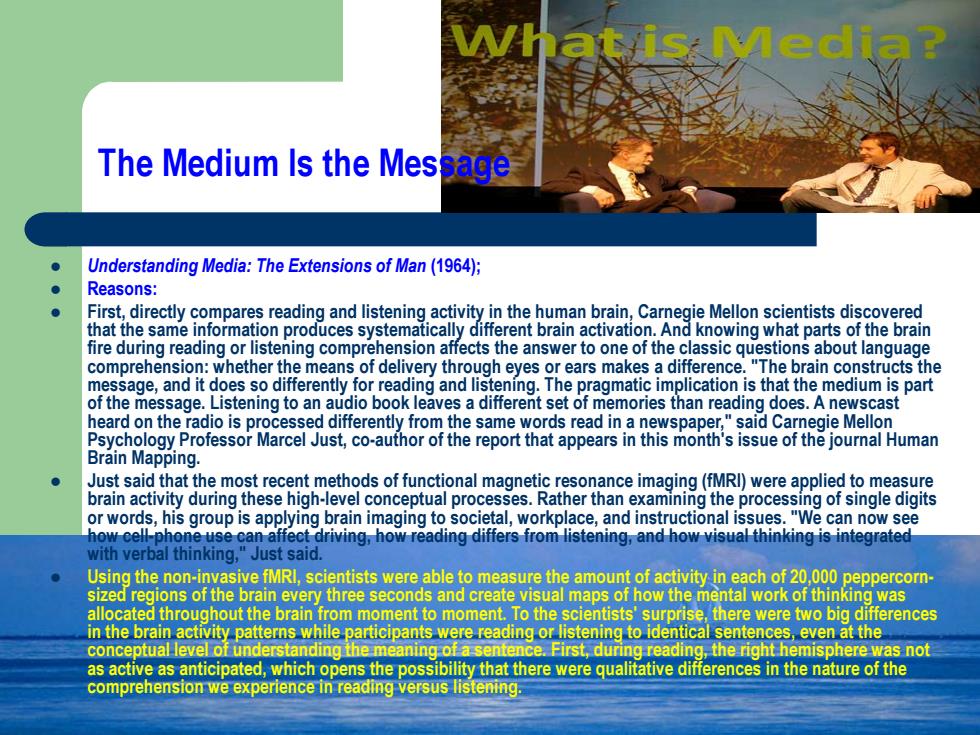
atis Media? The Medium Is the Message Understanding Media:The Extensions of Man(1964); Reasons: First,directly compares reading and listening activity in the human brain,Carnegie Mellon scientists discovered that the same information produces systematically different brain activation.And knowing what parts of the brain fire during reading or listening comprehension affects the answer to one of the classic questions about language comprehension:whether the means of delivery through eyes or ears makes a difference."The brain constructs the message,and it does so differently for reading and listening.The pragmatic implication is that the medium is part of the message.Listening to an audio book leaves a different set of memories than reading does.A newscast heard on the radio is processed differently from the same words read in a newspaper,"said Carnegie Mellon Psychology Professor Marcel Just,co-author of the report that appears in this month's issue of the journal Human Brain Mapping. Just said that the most recent methods of functional magnetic resonance imaging(fMRl)were applied to measure brain activity during these high-level conceptual processes.Rather than examining the processing of single digits or words,his group is applying brain imaging to societal,workplace,and instructional issues."We can now see how cell-phone use can affect driving,how reading differs from listening,and how visual thinking is integrated with verbal thinking,"Just said. Using the non-invasive fMRI,scientists were able to measure the amount of activity in each of 20,000 peppercorn- sized regions of the brain every three seconds and create visual maps of how the mental work of thinking was allocated throughout the brain from moment to moment.To the scientists'surprise,there were two big differences in the brain activity patterns while participants were reading or listening to identical sentences,even at the conceptual level of understanding the meaning of a sentence.First,during reading,the right hemisphere was not as active as anticipated,which opens the possibility that there were qualitative differences in the nature of the comprehension we experience in reading versus listening
Understanding Media: The Extensions of Man (1964); Reasons: First, directly compares reading and listening activity in the human brain, Carnegie Mellon scientists discovered that the same information produces systematically different brain activation. And knowing what parts of the brain fire during reading or listening comprehension affects the answer to one of the classic questions about language comprehension: whether the means of delivery through eyes or ears makes a difference. "The brain constructs the message, and it does so differently for reading and listening. The pragmatic implication is that the medium is part of the message. Listening to an audio book leaves a different set of memories than reading does. A newscast heard on the radio is processed differently from the same words read in a newspaper," said Carnegie Mellon Psychology Professor Marcel Just, co-author of the report that appears in this month's issue of the journal Human Brain Mapping. Just said that the most recent methods of functional magnetic resonance imaging (fMRI) were applied to measure brain activity during these high-level conceptual processes. Rather than examining the processing of single digits or words, his group is applying brain imaging to societal, workplace, and instructional issues. "We can now see how cell-phone use can affect driving, how reading differs from listening, and how visual thinking is integrated with verbal thinking," Just said. Using the non-invasive fMRI, scientists were able to measure the amount of activity in each of 20,000 peppercorn- sized regions of the brain every three seconds and create visual maps of how the mental work of thinking was allocated throughout the brain from moment to moment. To the scientists' surprise, there were two big differences in the brain activity patterns while participants were reading or listening to identical sentences, even at the conceptual level of understanding the meaning of a sentence. First, during reading, the right hemisphere was not as active as anticipated, which opens the possibility that there were qualitative differences in the nature of the comprehension we experience in reading versus listening. The Medium Is the Message
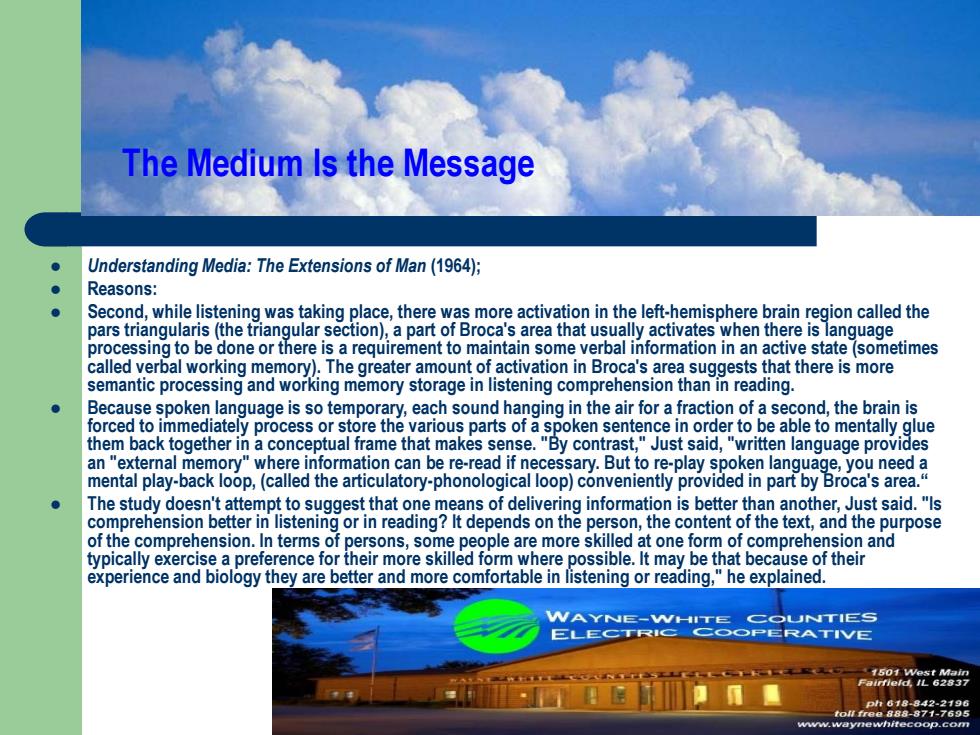
The Medium Is the Message ● Understanding Media:The Extensions of Man(1964); Reasons: Second,while listening was taking place,there was more activation in the left-hemisphere brain region called the pars triangularis(the triangular section),a part of Broca's area that usually activates when there is language processing to be done or there is a requirement to maintain some verbal information in an active state(sometimes called verbal working memory).The greater amount of activation in Broca's area suggests that there is more semantic processing and working memory storage in listening comprehension than in reading. Because spoken language is so temporary,each sound hanging in the air for a fraction of a second,the brain is forced to immediately process or store the various parts of a spoken sentence in order to be able to mentally glue them back together in a conceptual frame that makes sense."By contrast,"Just said,"written language provides an "external memory"where information can be re-read if necessary.But to re-play spoken language,you need a mental play-back loop,(called the articulatory-phonological loop)conveniently provided in part by Broca's area." The study doesn't attempt to suggest that one means of delivering information is better than another,Just said."Is comprehension better in listening or in reading?It depends on the person,the content of the text,and the purpose of the comprehension.In terms of persons,some people are more skilled at one form of comprehension and typically exercise a preference for their more skilled form where possible.It may be that because of their experience and biology they are better and more comfortable in listening or reading,he explained. WAYNE-WHITE COUNTIES ELECTRIC COOPERATIVE
The Medium Is the Message Understanding Media: The Extensions of Man (1964); Reasons: Second, while listening was taking place, there was more activation in the left-hemisphere brain region called the pars triangularis (the triangular section), a part of Broca's area that usually activates when there is language processing to be done or there is a requirement to maintain some verbal information in an active state (sometimes called verbal working memory). The greater amount of activation in Broca's area suggests that there is more semantic processing and working memory storage in listening comprehension than in reading. Because spoken language is so temporary, each sound hanging in the air for a fraction of a second, the brain is forced to immediately process or store the various parts of a spoken sentence in order to be able to mentally glue them back together in a conceptual frame that makes sense. "By contrast," Just said, "written language provides an "external memory" where information can be re-read if necessary. But to re-play spoken language, you need a mental play-back loop, (called the articulatory-phonological loop) conveniently provided in part by Broca's area.“ The study doesn't attempt to suggest that one means of delivering information is better than another, Just said. "Is comprehension better in listening or in reading? It depends on the person, the content of the text, and the purpose of the comprehension. In terms of persons, some people are more skilled at one form of comprehension and typically exercise a preference for their more skilled form where possible. It may be that because of their experience and biology they are better and more comfortable in listening or reading," he explained
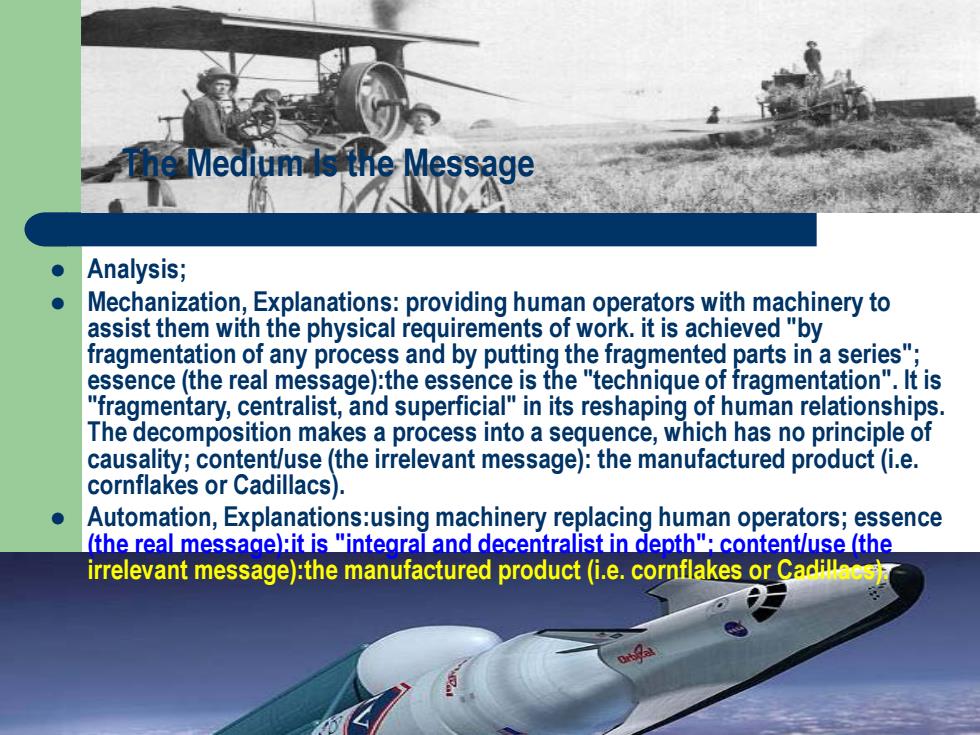
Che Mediumds the Message Analysis; Mechanization,Explanations:providing human operators with machinery to assist them with the physical requirements of work.it is achieved "by fragmentation of any process and by putting the fragmented parts in a series"; essence (the real message):the essence is the "technique of fragmentation".It is "fragmentary,centralist,and superficial"in its reshaping of human relationships The decomposition makes a process into a sequence,which has no principle of causality;content/use(the irrelevant message):the manufactured product(i.e. cornflakes or Cadillacs). Automation,Explanations:using machinery replacing human operators;essence (the real message):it is "integral and decentralist in depth":contentluse (the irrelevant message):the manufactured product (i.e.cornflakes or Cadiee
The Medium Is the Message Analysis; Mechanization, Explanations: providing human operators with machinery to assist them with the physical requirements of work. it is achieved "by fragmentation of any process and by putting the fragmented parts in a series"; essence (the real message):the essence is the "technique of fragmentation". It is "fragmentary, centralist, and superficial" in its reshaping of human relationships. The decomposition makes a process into a sequence, which has no principle of causality; content/use (the irrelevant message): the manufactured product (i.e. cornflakes or Cadillacs). Automation, Explanations:using machinery replacing human operators; essence (the real message):it is "integral and decentralist in depth"; content/use (the irrelevant message):the manufactured product (i.e. cornflakes or Cadillacs)
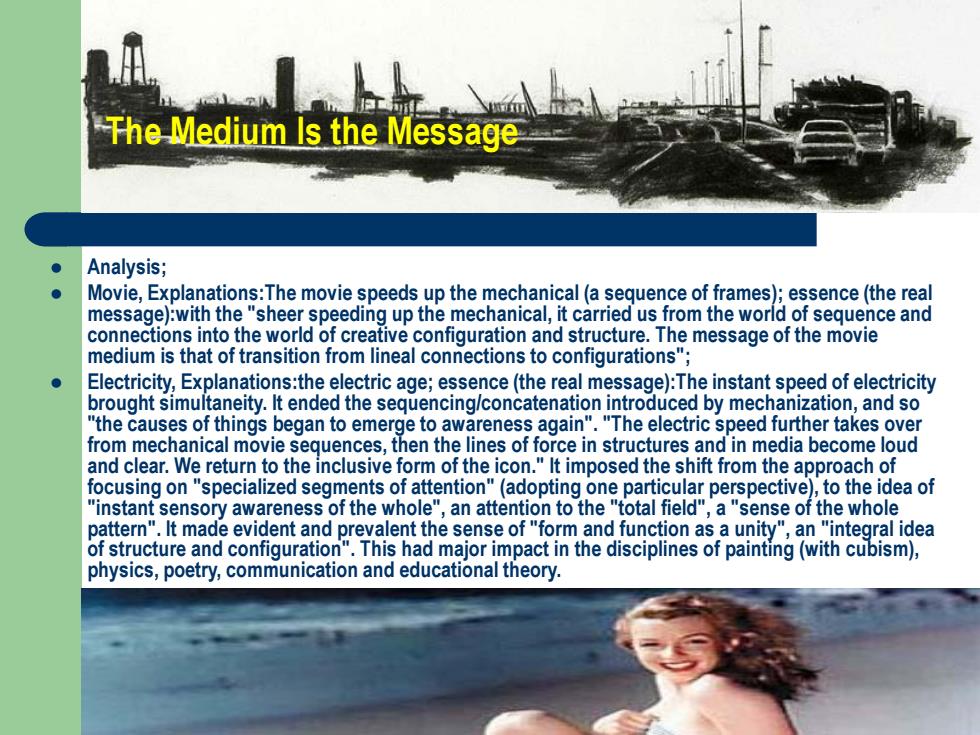
The Medium Is the Message Analysis; Movie,Explanations:The movie speeds up the mechanical(a sequence of frames);essence(the real message):with the "sheer speeding up the mechanical,it carried us from the world of sequence and connections into the world of creative configuration and structure.The message of the movie medium is that of transition from lineal connections to configurations"; Electricity,Explanations:the electric age;essence(the real message):The instant speed of electricity brought simultaneity.It ended the sequencing/concatenation introduced by mechanization,and so "the causes of things began to emerge to awareness again"."The electric speed further takes over from mechanical movie sequences,then the lines of force in structures and in media become loud and clear.We return to the inclusive form of the icon."It imposed the shift from the approach of focusing on "specialized segments of attention"(adopting one particular perspective),to the idea of "instant sensory awareness of the whole",an attention to the"total field",a "sense of the whole pattern".It made evident and prevalent the sense of "form and function as a unity",an "integral idea of structure and configuration".This had major impact in the disciplines of painting(with cubism), physics,poetry,communication and educational theory
The Medium Is the Message Analysis; Movie, Explanations:The movie speeds up the mechanical (a sequence of frames); essence (the real message):with the "sheer speeding up the mechanical, it carried us from the world of sequence and connections into the world of creative configuration and structure. The message of the movie medium is that of transition from lineal connections to configurations"; Electricity, Explanations:the electric age; essence (the real message):The instant speed of electricity brought simultaneity. It ended the sequencing/concatenation introduced by mechanization, and so "the causes of things began to emerge to awareness again". "The electric speed further takes over from mechanical movie sequences, then the lines of force in structures and in media become loud and clear. We return to the inclusive form of the icon." It imposed the shift from the approach of focusing on "specialized segments of attention" (adopting one particular perspective), to the idea of "instant sensory awareness of the whole", an attention to the "total field", a "sense of the whole pattern". It made evident and prevalent the sense of "form and function as a unity", an "integral idea of structure and configuration". This had major impact in the disciplines of painting (with cubism), physics, poetry, communication and educational theory
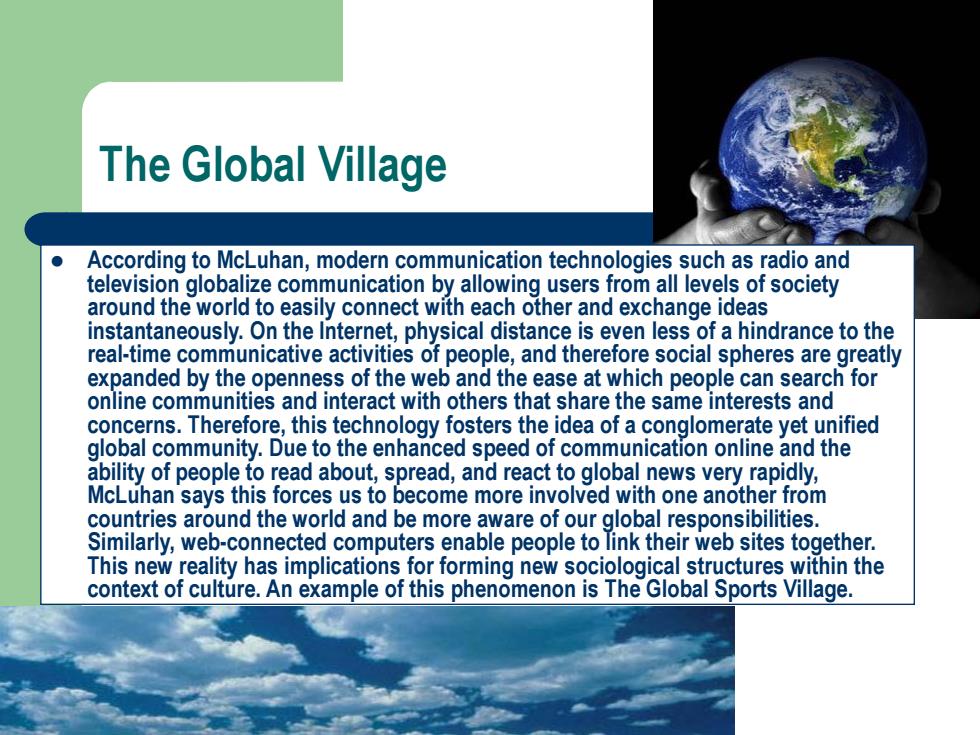
The Global Village ● According to McLuhan,modern communication technologies such as radio and television globalize communication by allowing users from all levels of society around the world to easily connect with each other and exchange ideas instantaneously.On the Internet,physical distance is even less of a hindrance to the real-time communicative activities of people,and therefore social spheres are greatly expanded by the openness of the web and the ease at which people can search for online communities and interact with others that share the same interests and concerns.Therefore,this technology fosters the idea of a conglomerate yet unified global community.Due to the enhanced speed of communication online and the ability of people to read about,spread,and react to global news very rapidly, McLuhan says this forces us to become more involved with one another from countries around the world and be more aware of our global responsibilities. Similarly,web-connected computers enable people to link their web sites together. This new reality has implications for forming new sociological structures within the context of culture.An example of this phenomenon is The Global Sports Village
The Global Village According to McLuhan, modern communication technologies such as radio and television globalize communication by allowing users from all levels of society around the world to easily connect with each other and exchange ideas instantaneously. On the Internet, physical distance is even less of a hindrance to the real-time communicative activities of people, and therefore social spheres are greatly expanded by the openness of the web and the ease at which people can search for online communities and interact with others that share the same interests and concerns. Therefore, this technology fosters the idea of a conglomerate yet unified global community. Due to the enhanced speed of communication online and the ability of people to read about, spread, and react to global news very rapidly, McLuhan says this forces us to become more involved with one another from countries around the world and be more aware of our global responsibilities. Similarly, web-connected computers enable people to link their web sites together. This new reality has implications for forming new sociological structures within the context of culture. An example of this phenomenon is The Global Sports Village